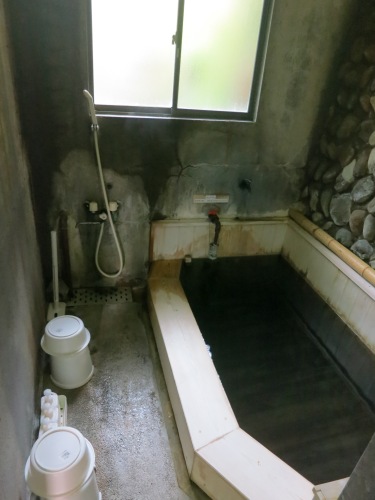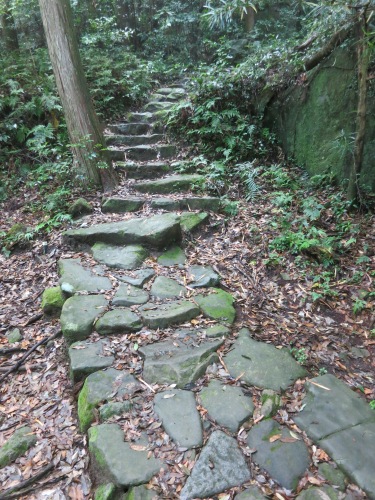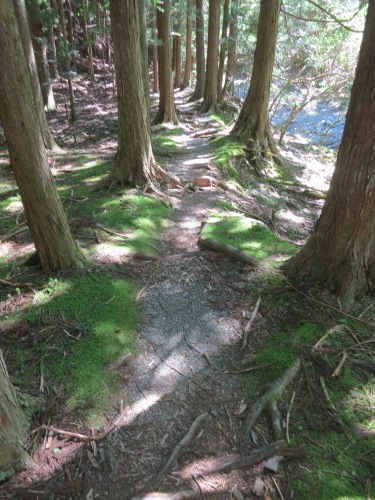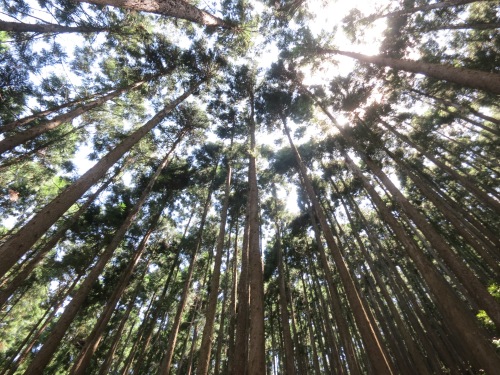Due South of Kyoto, in the Wakayama Prefecture, lies the Kii Peninsula, stretch of forest and mountains that has long been thought to be the home of many Shinto deities, or spirits, known as “Kami” — which later morphed into expressions of the Bodhisattva as the Buddhist and Shinto faiths became intertwined within Japan’s religious beliefs. As early as the Ninth Century, the country’s early emperors would make a pilgrimage to the region via the Kumano Old Road – now known as the Kumano Kodo – which would begin in the Old Capital of Kyoto, pass through the likes of Koya-san (which can be seen by clicking here), Tanabe, Hongu, and would finish somewhere in the mountains deep in the interior of the peninsula.
As the centuries passed, the popularity of the Kumano Old Road continued to grow, and an increasing number of pilgrims ranging from everyday citizens to wandering priests and poets would choose to make the trek to enjoy the natural surroundings, embark upon their own spiritual journey, pray at the various temples and shrines along the way, and to look upon the home of the Kami spirits themselves. Regardless of your religious affiliation, it is difficult to visit this part of Japan without getting the sense that there certainly is something special about the place.
Today, over a thousand years after the first retired emperors made their pilgrimages to the region, visitors can still embark upon their own spiritual experience. The Kumano Kodo isn’t just one particular path either, but is instead a series of different treks — most of which share the common ending point of the town of Hongu – allowing visitors and pilgrims to determine which route best fits their own specific journey. Additionally, the trails have all been restored, everything is marked in both Japanese and English, guides and maps are easy to find, and there is a variety of accommodation along the way (seeing as most journeys require at least several days of hiking). For my own path, I chose to hike the popular Nakahechi Trail, which begins just outside the town of Tanabe, takes you into the mountains for two grueling days of forest hikes and mountain summits – all while carrying your pack on your back through the intense heat and humidity of a Japanese summer — and finally finishes in Hongu. Once reaching my destination, I chose to make the nearby hot spring town of Yunomine Onsen my home base for another few days of exploring the surrounding region (more on that in Part Two, however). Here are a few photos for my time hiking the Kumano Kodo, which certainly does turn out to be far more than a simple walk in the woods:

The fact that moss covers every exposed surface is a testament to how rainy and humid this part of Japan can be

There are a variety of shelters and rest areas along the way – some are a bit more funky and unique than others

Although the majority of the trail passes over the mountains and through the woods, there is the occasional stretch along a nice bit of paved tarmac
As mentioned above, the Kumano Kodo is – and has been for many centuries – a spiritual pilgrimage, and as such, the path is dotted with various shrines, burial grounds, remains of former tea houses, and milestones of all sorts, each with its own character and history. Reading the plaques alongside each one gives a modern-day hiker the semblance of what it was like to make the pilgrimage many hundreds of years ago:
Beyond the shrines and temples, however, I took the most enjoyment from the solitary and solemn experience of hiking amongst bamboo and cedars trees, slowly climbing higher and higher, listening to the sounds of the forest, and then suddenly reaching the mountain pass that offers an amazing view back over the ground you’ve just covered or the first peak at a small village in the distance. The fact that this was an often repeated experience made it all the better:

The town of Chikatsuyu, where most hikers choose to stop and rest for the night. I, however, was stubborn, thought, “What’s a few more miles?” and chose to book my accommodation much farther down the trail (and over a few more mountains). Needless to say, in hindsight, my hubris was too great, and I was running on less than fumes by the time I stumbled into my lodge
Hiking through the forests on a spiritual journey isn’t the only appeal to visiting this part of Japan; in fact, half of the experience comes once you’ve stepped off the trail, slung off your heavy back-pack, and settled into to one of the many mountainside Minshuku (basically the Japanese version of a Bed and Breakfast) that dot the path. These accommodations offer typical Japanese-style rooms, with tatami mat floors and futons to sleep on, but they also take advantage of the areas bounty of bubbling hot springs (or “Onsen”), offering visitors a chance to soak away their sore muscles in steamy baths filled with mineral-rich water. It is the perfect way to end a long day of hiking:

An example of one of the Minshuku in which I stayed. This one was in the Tsugizakura area of the hike (where I did stay as opposed to Chikutsuyu, pictured above)

As expected, virtually all of the accommodation here comes in the form of Japanese-style rooms with tatami mat floors and low tables

Your tatami mat room also doubles as your sleeping quarters once your futon and bedding has been laid out

An example of a Japanese style bath (I particularly like the matching cedar wood tub, stools, and buckets). The proper etiquette is to use the stool, bucket, and facet to first wash yourself off thoroughly. Once you’ve rinsed off all of the soap, you can then move to the tub to soak for a while. Although in this example, the bath is only meant for one at a time, the bath water will still be left as is (thus the “wash before entering” and “no soap in the tub” rules), as it will be used by anyone else looking to soak later that night. This may seem odd to Westerners at first, but just think of it like you would a hot tub or Jacuzzi – and of course they change the water each day.

The unique character of the each inn’s bath differs from place to place. Seen here is a stand-alone bath made of stone that is then filled with mineral-rich spring water. Soothing…
After having soaked away all of your cares in your Minshuku’s bath or Onsen, it’s time to don a yukata (thin, pajama-like kimono) and sit down to dinner for the night, which is also provided as part of your stay. These mountain lodges don’t offer your average everyday fare, however; instead, they prepare elaborate feasts that roughly follow along the guidelines of a kaiseki meal (again, see my previous Kyoto post here for a kaiseki primer) — although some do choose to serve all of the evening’s dish at one time as opposed to a series of individual courses served over an hour or two. In fact, it is largely the cuisine the distinguishes one Minshuku from an another, and why visitors many may seek out one particular location over another (much like with the ryokan in other parts of Japan). Here is an example of a semi-kaiseki meal that I was served after my first day on the trail:

Tempura Vegetables with Green Tea Salt (on the left) and a cold dish of lightly cooked fish with apples (on the right)

Kamameshi Rice (steamed in this unique pot) finishes the savory side of the meal, alongside miso soup and pickles, of course
For variety’s sake (and because I know you guys love the food pictures almost much as I enjoy taking them), here are a few more meals from my time hiking the trails, as well as some close-ups shots of local foods specific to this region:
As suggested by the title of this post, this is only the first of two posts that I’ll have up on the Kumano Kodo. Whereas this first half examined both the hike itself and the experience of staying at Minshuku along the way, the second half will focus on the temples, shrines, and towns themselves that you pass by on your journey. Until then, cheers from the beautiful Kii Peninsula!

 August 7, 2013
August 7, 2013 







































Sounds like a beautiful experience!
It was definitely one of the highlights to my entire trip so far — I can’t wait to come back and hike the rest of it that I didn’t get to do!
How long is the Kumano Kodo? Or at least what you hiked?
I can’t remember the exact numbers, but I think I hiked about 18 km the first day, and 22 km the second day — which is something around 12 miles per day (I think). So it was long, but not CRAZY long. However, if I get to come back and hike around the areas I didn’t get to the first time around, I’m definitely coming in either the Spring or Fall, as the heat and humidity of the dead of Summer is what was really killer (especially since you had to carry a ton of water in with you, making your pack even heavier than it already was). Definitely worth the sweat, though!
Increible, sigue mandando post, esta genial tu viaje.
Thanks!
Wow Andrew, I can’t believe how exquisite the food looks even in a rural minshuku… the Japanese have clearly perfected it to an art! I had heard accounts of how much they usually serve at breakfast, but thanks to your photos I now have a better idea of the portions. Seems like it was as much of a culinary journey as a physical one on foot – and what a reward for your long hikes through the summer humidity!
Even in rural areas Japan never fails to impress me! I love how they combine sophistication with simplicity in a very elegant way. The food presentation, the onsen, the ryokan, so exquisite! I’ve been dreaming of going to Japan since I was little, but James and I might hold our plan to go there this winter. We’re planning to go somewhere else cheaper, at least for now. 🙂
It took me a while to be able to say this, but of all the countries I’ve been fortunate enough to be able to visit, Japan is my personal favorite (so far). But you are certainly correct: it is CRAZY expensive, and there is really no way around it. I do still like your idea of visiting in the winter, however, when there is a light dusting of snow to really complete the scene. I hope you make it here sooner than later!
For many years I never really understood why people wanted to visit Japan, but the more I read and see I am beginning to understand why. What a beautiful journey. The scenery during your hike looks stunning. Being able to combine that with seeing temples, shrines etc along the way sounds like an ideal trip to me. Food looks incredible as well as plentiful….good job you are hiking a good few kms every day:-)
I need to hike those few kms each day, if for nothing other than to burn off all the calories from all the food I was eating! 🙂
hi…i am planning to go there in May. Did you do it yourself without guide? i want to do it by myself.
Thanks
I did do it by myself, and I would highly recommend the trip solo (or, at most, with a significant other). And if you are worried about going solo, check the official site (below) for any info, lodging, eating, and maps that you could possibly need. Plus, going solo will allow you to branch out and meet more of the other travelers on the trail. This was one of my favorite parts of my entire RTW trip, so enjoy your time their in May!
http://www.tb-kumano.jp/en/kumano-kodo/
thanks for your reply. and yes, that’s the website i’ve been reading. i like going solo and i will walk combine with bus. is there any other trekker along the way? seems that this trail is less popular than Nara…can you recommend any budget hostel , dormitory is fine cos Japan is expensive 🙂
Been trying to find budget hostel along the Nakahechi trail but only got one in Hongu. any idea where to stay in Nachi?
Arigato!
You’ll definitely run into other trekkers along the trail (and in the towns), but don’t expect to find the crowds you’ll see in Nara — for better or worse, depending upon you’re perspective. Whereas you may choose to hike alongside other you meet, you’ll likely spend most of the time hiking in a solitary state.
And as far as budget accomodations, there unfortunately isn’t much to choose from, as you’re really out in the wilderness. The best bet is Hongu, as you mentioned. Personally, I made Yuminoe Onsen my homebase and just took buses to places like Nachi. Although they are expensive, I would advise staying in one of the onsen lodges for at least one night to get the experience. The price does also include an elaborate kaiseki dinner, a huge breakfast, and access to that lodge’s private onsen, so if you’re hiking that day, the accomodation will basically be your only expense.
Dear Andrew
While planning a trip to Kumano-Kodo I came across your blog, which I really liked and found helpful. If it is OK with you I would like to share my plan with you and ask for your opinion.
We only have two days to spend hiking so we were thinking to start in Tanabe, overnight in Chikatsuyu and Hongu. By your experience would that be a good choice given that we only have two days, or would you recommend another segment & overnights?
Regarding accommodation we found it difficult to pre-book. The places we found online are around 150 USD per night or above.
By your experience, is pre-booking necessary or is there plenty of local accommodation to walk into in? Is the price level we found reasonable? All other accommodation we booked in Japan up to now was less than USD 60 per night for a double…
We would really appreciate if you could share your experience with us on this one and hope to hear from you soon!
Safe travels! 🙂
Sonja & Julian
I just sent you an email. Let me know if there is anything else I can help with!
Hi Andrew, I second everything said in the post right above : ) I was really hoping for a public reply regarding the need to pre-book accommodation and the prices to expect. I’ll be hiking solo and if needed I’ll book in advance to avoid wandering around small towns trying to find a place to stay. However, from your experience: would that be a concern at all?
Another question: can you stock up on food/drinks in the overnight stops? Will the ryokans prepare a lunch pack for along the way?
Very much looking forward to following in your footsteps and those of the pelgrims who went before : ) And thanks for a lovely blog, very nice and informative read!
Hello Marina,
The various stops along the trail are all very small and isolated with only a handful of accommodations, so I would very strongly suggest booking ahead. It would be unfortunate to hike all day only to show up tired and not have a place to stay — ha ha. As far as pricing, it will vary by season and accommodation, but the official Kumano Kodo website has a booking function where you can see the various price levels on the days you’re looking to stay.
As far as stocking up, the town of Tanabe (where most people start) will have plenty of options as far as grocery stores and convenience marts. Once you’re hiking, however, only the small towns where you would stay would have anything available (Hongu, Nachi-san, Shingu would have more options, the various onsens towns will have less), and I would count on those being limited. Luckily, however, most of the accommodations will feed you dinner when you arrive, breakfast the next morning, and will send you off with a packed lunch. You’ll have to check with the specific Minshuku you choose to be sure, but most should offer that option.
Hopefully that answers your questions, but let me know if you need anything else, as I’m happy to help. Best of luck on your trip, and your own walk in the woods!
Thanks so much for your kind and informative reply, Andrew! I will certainly follow your advice to book accommodation along the trail in advance. Much looking forward to it!
Kind regards, Marina
I might try to hike part of the Kumano Kodo in two weeks. Kind of a last minute trip long weekend trip from Taiwan. Great blog.
Thanks, and enjoy your hike!
Hi Andrew!
Thanks for the information you posted on the Kumano Kodo. I’m planning to to do this with my wife next year (We hiked the Sarria to Santiago de Compostela stage) of the Camino this year. My questions are: 1. You said you only did 2 days of walking. How many days/miles is it in total? 2. Would you mind sharing your itinerary from arrival in Kyoto and back?
Thank much!
Regards,
Martin
Hi Martin!
To answer your first question, I did only do 2 days of solid hiking — starting in Tanabe and finishing in Yunomine Onsen. After that, I did do a number of smaller day-hikes with Yunomine Onsen as my “home base,” but there were many trails I didn’t hike. I’m not sure how many miles make up the Kumano Kodo in total, as it isn’t one single trail but is a collection of many different trails all in the same region of Japan that all inter-connect. So it is really a “build your own adventure” type of experience, where you can hike for as little as one or two days, and upwards of several weeks if you are in for more of a long-haul experience. Some additional info on the various trails can be found on the official Kumano Kodo website:
http://www.tb-kumano.jp/en/kumano-kodo/
To answer your second question, I don’t remember the specifics of my itinerary, but after flying into Kyoto and spending several days overcoming jet lag, I took a train from Kyoto to the small town of Tanabe. There isn’t a direct train, as you’ll have to change at least once on your way there, but the Japan Rail Line website should give you all the info you need as far as getting to and from the various cities in the area. The JR Railways website for the Central region is linked below:
http://english.jr-central.co.jp/
Have fun planning your trip and enjoy your time in Japan!
Thanks a bunch, Andrew!